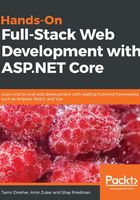
.NET Core
ASP.NET Core is built on .NET Core, which is Microsoft's cross-platform CLR implementation. This enables ASP.NET Core and other frameworks to run smoothly on operating systems other than Windows. It was rewritten from scratch to support modern backend development, unlike the full .NET Framework, which was developed to support any coding scenario. .NET Core and the .NET Framework can coexist, even on the same project, and no plans to change this have been announced by Microsoft to this date.
.NET Core, like the full .NET Framework, implements the .NET Standard Library—if you're familiar with the .NET Framework, you will feel at home quickly. A big difference with .NET Core is the fact it does not rely on assemblies or the Global Assembly Cache (GAC). However, all needed libraries are used as packages that are retrieved from NuGet, the .NET package manager. For example, if you need to use System.IO, you can get it from NuGet as a separate library, without the need to add and load the entire System assembly.
In addition, .NET Core comes with the .NET Core Command-Line Interface (CLI), a utility that enables developers and IDEs to execute .NET Core commands on any platform. Commands for things such as creating a new project, adding packages, building, or publishing the solution can all be done via the .NET Core CLI. For example, creating a new ASP.NET Core application is as simple as executing the following line on the Command Prompt:
dotnet new web
This enables endless automation scenarios, as well as a new wave of brand new cross platform .NET IDEs. We will cover the .NET Core CLI in more depth throughout this book.